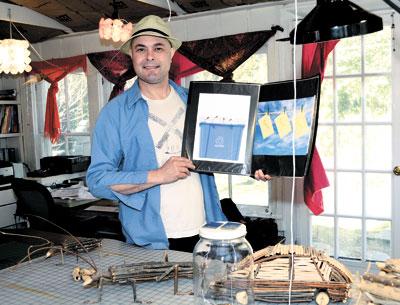Rossa Cole: The Photo’s the Thing, or Is It?

Over several weeks last fall, late-season coastal storms and the Sandy Hook School shootings overwhelmed human emotional response. People who lost homes are still trying to put the pieces back together and those who lost loved ones will never be the same.
Rossa Cole well remembers the days after Hurricane Sandy came ashore on Oct. 29 in southern New Jersey. The slow-moving storm lasted for days and spread its damaging winds and rain in a wide swath that hit areas of New York City and western Long Island particularly hard. Here, the high tide line of the storm was evident by the line of detritus in its wake, well over the dunes.
Mr. Cole, a Sag Harbor photographer and sculptor who has built a body of work utilizing the cast-offs of others, found himself collecting accumulated bits of flotsam and jetsam, not sure of their ultimate purpose, but certain of their metaphorical weight.
He said recently that it became clear to him what to do with the objects after the morning of Dec. 14, when 20 children and six adults were fatally shot in Newtown, Conn. And so he began his process, similar to how he had built gulls, penguins, dolphins, and other creatures from wire and found six-pack rings, and went online to get a visual model of the guns Adam Lanza had used. Then he set to work, replicating them with an aggregation of old lighters, tampon applicators, pacifiers, spray bottle tops, and actual shotgun shell casings, among other bits of plastic, rubber, and metal.
He has three from this series, titled simply by their manufacturer and including the assault rifle Lanza used to blow his way through the school’s front door as well as two semiautomatic handguns, all rendered to approximate scale. The brightly colored materials make the guns appear toy-like but they are recreated faithfully enough that they still look menacing. Yet they seem, like most of his work, to be about hope, even aspirations, and certainly rebirth.
Mr. Cole, whom some may remember from the pages of this newspaper as a staff photographer, began making his ecologically themed sculpture a few years ago. Known for years for his event and society photography, “I was ready for something different,” he said. “I worked as an assistant to a commercial still-life photographer,” Charles Nesbit, who photographs jewelry, makeup, liquor and the like with an edgy, dramatic flair.
Inspired to bring some of the techniques he learned into his own artistic projects, “I realized I needed a theme. I chose ecology.” He started taking “green” pictures, “messing around with Photoshop” to create interesting backdrops and juxtapositions. But eventually, he came upon a vision of an object he couldn’t quite realize in Photoshop — a plug made of natural materials to promote the use of clean power sources. “So I decided to build it myself.”
The result was a realistic-looking plug formed solely from small pieces of cut wood. But Mr. Cole didn’t stop there. He realized there were other things he wanted to see made and plenty of material to make them with — and all of it free. He began collecting cast-offs from neighbors in Greenpoint, Brooklyn, where he keeps a studio: fishing lure remnants, six-pack rings, old cellphone motors, and solar panels from outside lights. These became his medium to create kinetic and sound sculptures, lacy and evanescent animal sculptures, lamps, dioramas, and other installation-themed objects.
One of the more striking results of these labors are his sea animal pieces made of six-pack rings. He started with a seagull, working from photographs to get the shape correct in wire and then cladding the body with the rings, attaching them with plastic ties.
It takes him about two days to wrap a gull. The result is a light and lacy vision, delicate yet substantial and prone to eventual decomposition. He’s moved on to penguins, dolphins, and a sea turtle, and is already planning to rewrap an early seagull whose rings broke down. He aims for a cleaner look than those earlier versions, now using fishing wire to hold the rings down and make them disappear. He said he liked the natural symmetry of the gulls and all of his nature studies. His pieces, too, are completely symmetrical.
Mr. Cole continues to work in wood as well, fashioning a house model with references to ideas for greener living. He also built a small model of the Deepwater Horizon rig that blew up in the Gulf of Mexico and caused massive oil spills and devastation to the region. His series of photographs of motor oil and water not mixing also refer to that disaster.
In fact, while he continues to make sculptures, and they exist as stand-alone pieces, most often the photograph he uses them in is their highest realization. Not that you’d know it from his Sag Harbor studio, where all the objects and the materials he uses to make them are accumulating around him.
“The photo is what is left of the process,” he said. “They’re meant to be shared.” They also survive as documents, if and when the objects disappear.
